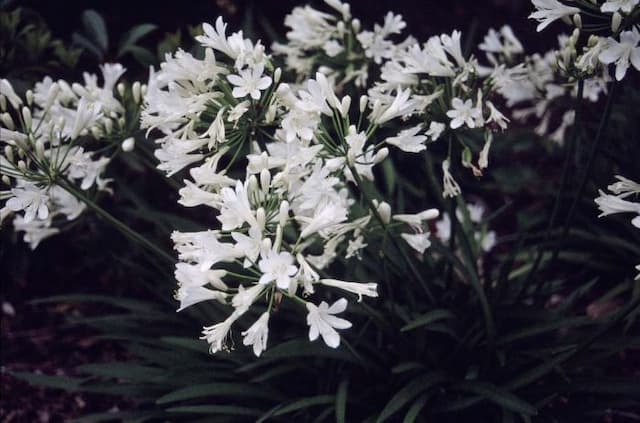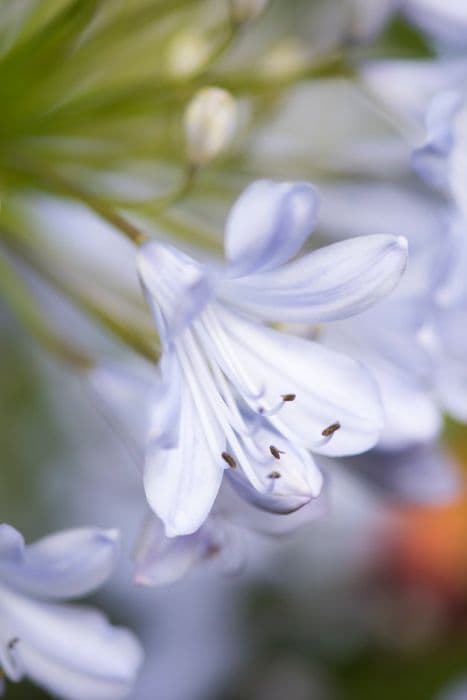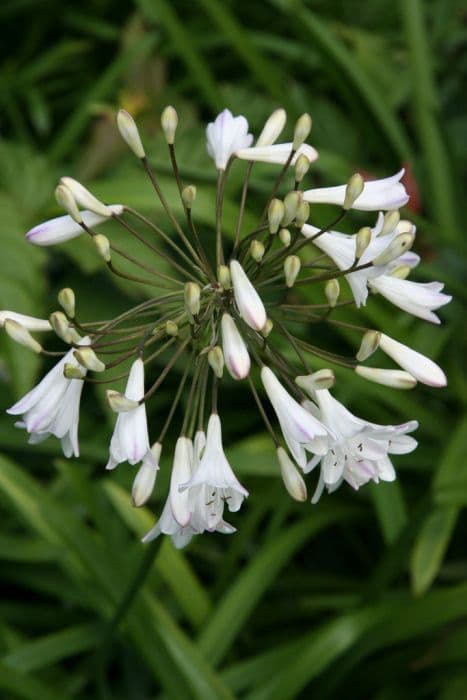African Lily Agapanthus inapertus

ABOUT
Agapanthus inapertus, commonly known as 'African Lily' or 'Lily of the Nile', is a striking plant renowned for its beautiful flower displays. The plant boasts strappy, green leaves that emerge from a fleshy rhizome. These leaves have a glossy appearance and can often have a leathery texture, forming a lush, dense clump at the base of the plant. The most distinctive feature of the African Lily is its striking flowers. These flowers are bell-shaped and typically come in shades of deep blue or violet, although some variations with different shades may exist. They are arranged in a large, rounded cluster at the end of a long, upright stem that rises above the foliage. Each cluster consists of multiple individual blooms, creating a magnificent spherical display that attracts various pollinators such as bees and butterflies. Despite the removal of the size, it's worth noting that the flowers and foliage together create an impressive silhouette that contributes to the plant's ornamental value. The long-lasting flowers bloom during the summer months, making African Lily a popular choice for gardeners and landscape designers looking to add a touch of drama and color to their outdoor spaces. The African Lily's visual appeal is further enhanced when planted in groups, where multiple flower clusters create a stunning visual impact.
About this plant
 Names
NamesFamily
Amaryllidaceae.
Synonyms
Drooping Agapanthus, Closed African Lily, Pendulous Agapanthus, Mountain Agapanthus.
Common names
Agapanthus campanulatus, Agapanthus inapertus subsp. Pendulus, Agapanthus inapertus var. Hollandii, Agapanthus inapertus var. Pendulus, Agapanthus inapertus var. Huttonii, Agapanthus inapertus var. Gratus, Agapanthus inapertus var. Parviflorus, Agapanthus campanulatus var. Huttonii, Agapanthus parviflorus.
 Characteristics
CharacteristicsLife cycle
Perennials
Foliage type
Deciduous
Color of leaves
Green
Flower color
Blue
Height
2 feet [60 cm]
Spread
2 feet [60 cm]
Plant type
Bulb
Hardiness zones
8
Native area
South Africa
Benefits
 General Benefits
General Benefits- Ornamental Appeal: The strikingly attractive blue, tubular flowers of the Agapanthus inapertus add aesthetic value to gardens and landscapes.
- Drought Tolerance: Adapted to survive with minimal watering, making it suitable for drought-prone areas or low-water gardens.
- Low Maintenance: Requires minimal care once established, with infrequent need for fertilization or pruning.
- Erosion Control: The root system helps stabilize the soil, reducing erosion on slopes and banks.
- Attracts Pollinators: The flowers provide nectar for bees, butterflies, and other beneficial pollinators, helping to support local ecosystems.
- Long Bloom Period: It has a long flowering season, typically providing blooms throughout summer, which keeps gardens vibrant for an extended period.
- Deer Resistance: Generally resistant to deer, which makes it a good choice for gardens in areas where deer predation is a concern.
 Medical Properties
Medical PropertiesThis plant is not used for medical purposes.
 Air-purifying Qualities
Air-purifying QualitiesThis plant is not specifically known for air purifying qualities.
 Other Uses
Other Uses- As a trap plant for slugs and snails: Agapanthus can be used in gardens to lure these pests away from more vulnerable plants, as they are attracted to the mucilage in the leaves.
- As a dye plant: The blue and purple hues of agapanthus flowers can be used to create natural dyes for textiles and crafting materials.
- In coastal erosion control: Agapanthus, with its robust root system, can help stabilize soil and prevent erosion on coastal properties.
- As a flower arrangement staple: Agapanthus is commonly used in floral arrangements for its tall, striking flowers which hold well in both fresh and dry bouquets.
- In companion planting: Gardeners plant agapanthus near rose bushes to complement the environment and potentially deter certain pests through interplanting.
- As a living mulch: The dense foliage of agapanthus can suppress weeds and retain soil moisture when used as ground cover.
- In artistic inspiration: The unique structure of agapanthus blooms often inspires patterns and motifs in textiles, ceramics, and other art forms.
- As a boundary marker: Due to their clumping nature and impressive height when in bloom, agapanthus is sometimes used to define property lines or garden sections.
- For water-wise gardening: Agapanthus is drought-tolerant and can be used in gardens that are designed to conserve water.
- In frost protection: Agapanthus can be planted amongst frost-sensitive plants, as they can tolerate cold and provide some degree of shelter to neighboring flora.
Interesting Facts
 Feng Shui
Feng ShuiThe Agapanthus is not used in Feng Shui practice.
 Zodiac Sign Compitability
Zodiac Sign CompitabilityThe Agapanthus is not used in astrology practice.
 Plant Symbolism
Plant Symbolism- Love Letters: The Agapanthus, commonly known as the African Lily, often symbolizes love letters. Its funnel-shaped blossoms can be seen as a metaphor for the envelope containing a message of affection.
- Enduring Love: The African Lily's robust nature and perennial growth represent long-lasting and enduring love, suggesting a relationship that withstands the test of time.
- Beauty: With its striking blue to violet flowers, the Agapanthus embodies beauty, elegance, and a unique aesthetic that is often celebrated in gardens and floral arrangements.
- Home: In some cultures, the African Lily is a symbol of home or domesticity due to its large, round umbels of flowers that provide a focal point much like a home does within a community.
- Prosperity: Sometimes, the African Lily is associated with prosperity, blooming profusely, it suggests abundance and growth in one's personal or professional life.
 Water
WaterThe Agapanthus, commonly known as the African Lily, should be watered thoroughly, allowing the soil to become moist but not soggy. During the growing season, it typically requires watering once every week, using approximately 1 gallon of water per plant for outdoor lilies, while potted indoor varieties may require slightly less. The soil should be allowed to dry out somewhat between waterings to prevent root rot. In hotter, drier climates, African Lilies may need more frequent watering, whereas in cooler climates, they may need less. During winter dormancy, reduce watering significantly, providing just enough to prevent the soil from completely drying out, perhaps every two to three weeks depending on indoor conditions.
 Light
LightAfrican Lily thrives best in full sun to partial shade. An ideal spot would be where the plant receives at least six hours of direct sunlight but is shielded from the scorching afternoon sun, especially in hotter climates. Providing bright light encourages robust growth and plentiful flowering, so positioning the plant in an area with plenty of natural light is essential.
 Temperature
TemperatureAfrican Lilies prefer moderate temperatures and can typically withstand a minimum temperature of around 50 degrees Fahrenheit. They perform best in temperatures ranging from 60 to 75 degrees Fahrenheit. It's important to protect them from temperatures below 50 degrees Fahrenheit, as cold temperatures can damage or kill the plant. The ideal temperature conditions maximize growth and flowering potential.
 Pruning
PruningPruning African Lily involves deadheading spent flowers to encourage further blooming and maintain a tidy appearance. At the end of the blooming season, typically in late summer or early fall, cut back the flower stalks to the base to promote healthy new growth for the next season. Full pruning is not often required, but it is beneficial to remove any dead or damaged leaves as necessary to keep the plant looking its best.
 Cleaning
CleaningAs needed
 Soil
SoilThe African Lily thrives in a soil mix with good drainage; a blend of loam, sand, and compost is ideal, with a pH between 6.0 and 8.0.
 Repotting
RepottingAfrican Lilies should be repotted every 3 to 4 years, or when they become root-bound in their current container.
 Humidity & Misting
Humidity & MistingAfrican Lilies prefer moderate humidity levels but are quite adaptable and can tolerate the dry air found in most homes.
 Suitable locations
Suitable locationsIndoor
Place in bright, indirect light and ensure good airflow for African Lily.
Outdoor
Choose a sunny spot with well-draining soil for African Lily.
Hardiness zone
8-10 USDA
 Life cycle
Life cycleThe life of the African Lily (Agapanthus inapertus) begins with the germination of seeds planted in well-drained soil, ideally in the spring after the threat of frost has passed. After germination, the seedlings grow into juvenile plants, developing a clump of strap-shaped leaves. As the plants mature, usually after a couple of years, they enter the flowering stage during summer when tall stalks rise above the foliage, topped with clusters of bell-shaped flowers ranging from dark blue to violet. Following the flowering stage, the plant produces seed pods that ripen, split open, and release seeds to complete the reproductive cycle. In addition to seed propagation, African Lilies can also spread vegetatively through the division of their root systems or offsets. Over time, the plants will go through a period of dormancy in the winter, during which above-ground foliage may die back, especially in cooler climates, before regrowing in the spring.
 Propogation
PropogationPropogation time
Spring to early summer
Propogation: The most popular method of propagating Agapanthus inapertus, commonly known as Lily of the Nile, is through division. This is generally done in the spring, after the threat of frost has passed but before the plant enters its rapid growth phase. To propagate by division, carefully dig up the clump of Agapanthus, ensuring that you get as much of the root system as possible. Gently tease apart individual crowns with a sharp knife or spade, each with a separate section of roots. Replant these divisions into well-preparing soil, spacing them approximately 12 to 18 inches apart (or 30 to 45 centimeters apart) to give them room to grow. Water the newly planted divisions thoroughly to establish them in their new locations. This method not only helps propagate the plant but also invigorates older clumps that may have become too dense, resulting in more vigorous growth and better blooms.



![African lily [Blue Storm]](/_next/image?url=https%3A%2F%2Fplants-admin.emdemapps.com%2Fimages%2Fplants%2F%2Fimages%2F604b63200a08b.png&w=640&q=75)





